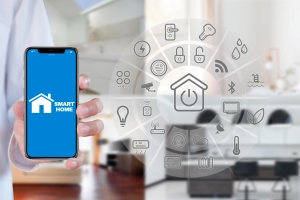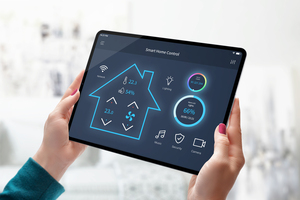The power of IoT home automation
The idea of a smart home is not something new, however with the expansion of Internet of Things (IoT) in recent years, it’s becoming more and more of a norm for many. IoT home automation promises to transform living spaces, making them more productive, secure and convenient.
Home IoT automation involves the use of smart technologies, including household appliances, automated controls and other devices that are connected to a network and can control, automate and communicate on behalf of the resident or occupant of a home environment. These devices are equipped with sensors, actuators and communication modules. They collect data and create contextual information to make decisions and perform tasks autonomously. Such systems can provide value and improve quality of life by making everyday tasks more simple and effective, improving energy use and reducing home heating and cooling consumption, and making homes safer by automatically alerting people of fire or flooding.
The benefits of home IoT automation
Some of the biggest benefits of home IoT automation lie in its convenience factor. Imagine waking up to your favourite tracks, your coffee machine already working for you and the thermostat kicking at the correct temperature. Everything would be arranged in a well-designed home automation system. Automating mundane tasks saves time and reduces the cognitive load of managing household chores.
Energy efficiency is another big benefit. Smart thermostats, for example, learn your schedule and preferences and will turn up or down heating and cooling to be energy-efficient, while smart lighting automatically turns off lights in rooms that you’re not using and adjusts its brightness accordingly to the natural light. All of this can amount to notable energy savings.
| Benefit | Description | Statistics/Examples |
|---|---|---|
| Convenience | Automates daily tasks, reducing cognitive load and saving time. | – Waking up to music, pre-made coffee, thermostat at correct temperature. |
| Energy Efficiency | Smart devices optimise energy usage, leading to significant savings. | – Smart thermostats: 10%-15% energy savings. – Smart lighting: 7%-27% energy savings. – General home automation: 13% reduction in carbon emissions. – Nottingham reduced carbon emissions by 26% since 2005. |
| Cost Savings | Reduction in energy bills due to optimised energy usage. | – Bills can be reduced by 5%-22% depending on automation level. |
| Home Security | Enhanced security through smart systems with real-time alerts, remote monitoring and controlled access. | – Connected cameras, motion sensors, and door locks managed via smartphone. |
Reports and researches state that smart thermostats can cut energy usage from 10% to 15%. Smart lighting can save energy anywhere between 7% and 27%. Home automation in general can cut carbon emissions of a household by around 13%. The city of Nottingham in the UK managed to lower its carbon emissions by 26% since 2005 with home automation of its citizens. Depending on the level of your home’s automation, you can cut your bills by between 5% and 22%. Keep in mind that technology continues to progress, which means that these percentages can still increase.
Home security is always a central concern for the homeowner, and IoT automation can help in a number of different ways. For example, with smart security systems you can have connected cameras, motion sensors and door locks that are all in a single control system, operated using your smartphone. You can be alerted in real-time if anything suspicious is going on, monitor your home remotely if you are not there, and also allow visitors in using an access code provided by you from afar. This all serves to provide peace of mind in that you can be confident that your home is secure 24 hours a day.


Key components of home IoT automation
At the core of a home IoT automation system are devices such as smart speakers, thermostats, lighting systems, security cameras, door locks and appliances. A home automation hub functions as the centralised control centre for command and control of all of these devices, thereby allowing them to work together harmoniously. With a simple voice command, homeowners can control the devices, commanding them to dim the lights, change thermostat settings, play a song or create an automation routine.
Mobile apps form another critical component at the user interface level, giving us control over home automation. They enable us to monitor and adjust the status of devices and facilities, and even set up automation routines no matter where we are, whether that’s in the office, on holiday or at home.
Challenges and considerations
The benefits of IoT automation at home are exciting, but that technology comes with other hurdles, like security and privacy We’ve already seen the problems that can occur when anything connected to the internet is hacked. It’s only a matter of time before similar problems arise with devices in your home, such as networked kitchen scales, talking dolls and other ubiquitous technologies. So, what can you do to ensure the technology comes with other hurdles, like security and privacy addressed? With IoT devices, it’s up to you to make sure that they’re adequately protected by security safeguards such as strong passwords, software updates and encryption.


Another interoperability issue arises from the incompatibility between different devices and platforms. You need to be careful when you set up a home automation system because some devices cannot be integrated. Products with a better chance of interoperability are those that follow a common standard or protocol. For example, Zigbee and Z-Wave are two common wireless standards for building home automation systems.
But when buying a system, the initial spend could be substantial. A basic system that includes a smart thermostat and some smart outlets can cost US$300-$500. Something more complex, such as security systems and smart lighting can range from US$1,000 to US$5,000. And a very detailed home automation project with smart water sensors, maybe a home theatre and smart kitchen can go as high as US$10,000. It’s not a small expense. That’s why it is advisable to start gradually with a few pieces of connected kit and build your system up over time.
The future of home IoT automation
IoT automation in our homes will only become more elegant and intelligent as technology advances and consumers learn to trust and embrace it. Some of the most exciting advancements for home IoT are being made through artificial intelligence (AI) and machine learning (ML): AI that learns about your usage patterns and adjusts your systems to maximise efficiency and comfort.
It could be melded with other technologies such as augmented reality (AR) or blockchain, to improve functionality and security. An AR-based control interface could give users greater immersion, and blockchain could deliver secure and decentralised control of connected devices.
As smart building technology matures, more things, devices and systems will be networked. Whatever approaches we take, the potential for innovation is immense.
IoT automation is bringing a new sense of comfort. If you’re a homeowner looking to make smart moves in home IoT automation, equip yourself with the knowledge about its benefits, components and challenges, so you can make well-informed decisions before making the switch. But we can be certain of one thing: IoT will continue to evolve, and the home will become more adaptable and more responsive.
Comment on this article via X: @IoTNow_ and visit our homepage IoT Now
